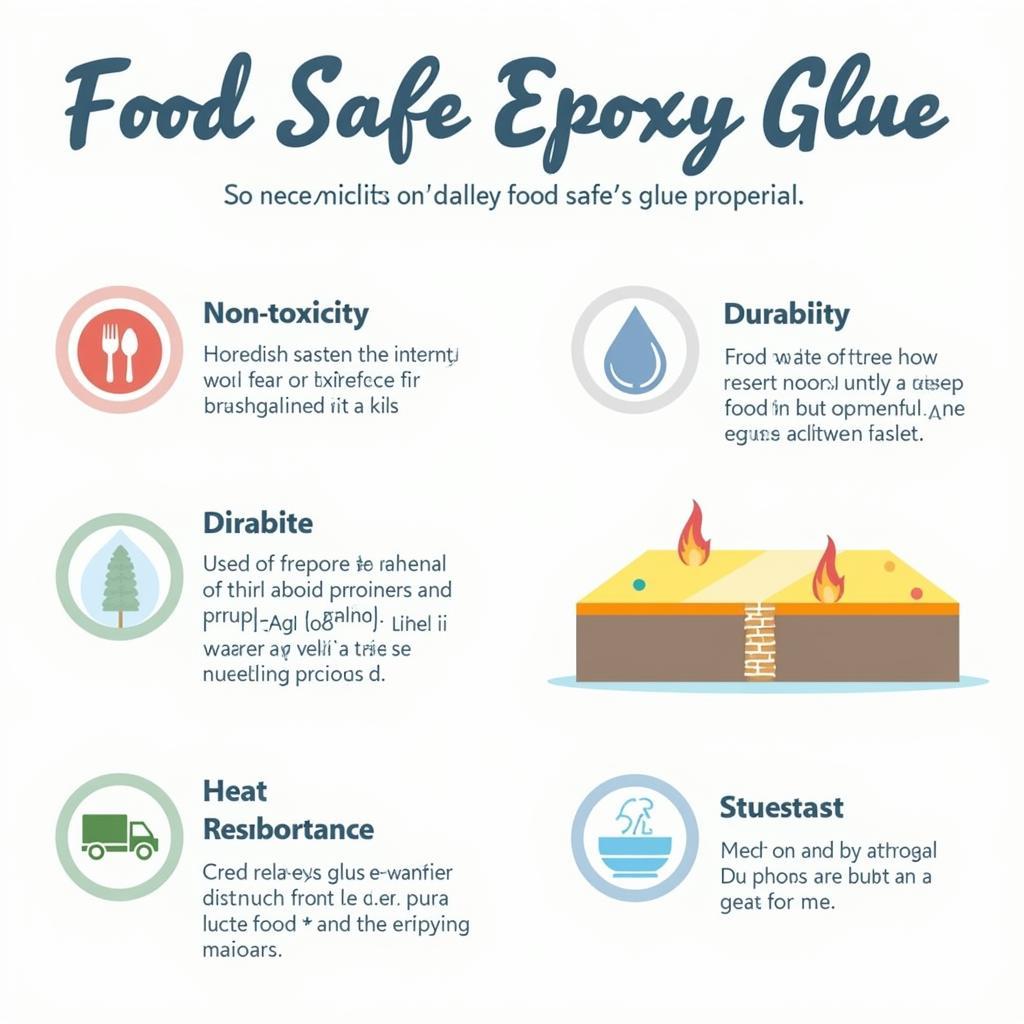Food Safe Epoxy Glue is a crucial component in many food-related applications, from repairing chipped plates to creating stunning resin art for serving platters. Choosing the right epoxy and ensuring proper application is essential for both aesthetics and, most importantly, safety. This guide will delve into the world of food safe epoxy glue, covering everything from its properties and uses to safety precautions and best practices.
Is epoxy really food safe? What makes one epoxy safe for contact with food and another not? Understanding the complexities of epoxy resins is the first step in making informed decisions about their use in food-related projects. We’ll explore the different types of epoxy, their chemical composition, and what “food safe” actually means. You’ll also learn about food safe glue options besides epoxy.
What Does Food Safe Epoxy Glue Mean?
Not all epoxies are created equal. The term “food safe” indicates that after the epoxy has fully cured, it won’t leach harmful chemicals into food. This means the cured epoxy forms an inert barrier, preventing any interaction between the epoxy and the food it comes in contact with. It’s crucial to look for certifications that specifically designate an epoxy as food safe, often meeting FDA standards.
Key Properties of Food Safe Epoxy Glue
Food safe epoxy glue possesses several key properties that make it suitable for food-related projects:
- Non-Toxic: Once cured, it does not release harmful chemicals.
- Durable: It can withstand regular use and cleaning.
- Water-Resistant: Essential for items that will come in contact with liquids.
- Heat-Resistant: Able to withstand moderate temperatures, preventing warping or melting.
 Food Safe Epoxy Glue Properties Illustrated
Food Safe Epoxy Glue Properties Illustrated
Common Applications of Food Safe Epoxy Glue
Food safe epoxy glue finds use in a wide array of applications, including:
- Repairing ceramic dishes and mugs
- Creating decorative serving trays and coasters
- Sealing wooden cutting boards and utensils
- Crafting unique resin jewelry and art for food presentation
- Repairing or creating doll house food miniatures
Choosing the Right Food Safe Epoxy
Selecting the correct epoxy is crucial. Consider the specific project, the materials involved, and the intended use. Read product labels and data sheets carefully to ensure the epoxy is certified food safe. Some epoxies are explicitly designed for food contact, while others achieve food-safe status after curing.
“Always double-check certifications and ensure the epoxy is explicitly stated as food safe for direct contact,” advises Dr. Emily Carter, a materials scientist specializing in polymer chemistry. “The curing process is also crucial for achieving true food safety, so follow manufacturer instructions meticulously.”
Safety Precautions When Using Epoxy
While food safe epoxy glue is designed for contact with food, certain precautions should be taken during application:
- Ventilation: Work in a well-ventilated area to avoid inhaling fumes.
- Gloves: Wear gloves to protect your skin from contact with the epoxy.
- Eye Protection: Use safety glasses to prevent eye irritation.
- Surface Preparation: Ensure surfaces are clean and dry before applying epoxy.
Curing Time and Temperature
Proper curing is essential for food safety. Follow manufacturer guidelines for curing time and temperature. Insufficient curing can compromise the epoxy’s integrity and potentially leach chemicals into food. Rushing the process can negate the “food safe” designation. You can also learn about food safe sealant for glass if that’s more relevant to your needs.
“The curing process is critical,” emphasizes John Miller, a seasoned craftsman with years of experience using epoxy resins. “Temperature and humidity play a significant role in the final outcome. Patience is key to achieving a food-safe finish.”
How to Clean Food Safe Epoxy Surfaces
Once cured, food safe epoxy surfaces can typically be cleaned with soap and water. Avoid abrasive cleaners or harsh chemicals, which could damage the epoxy finish.
Conclusion
Food safe epoxy glue provides a versatile solution for various food-related projects. By understanding its properties, applications, and safety precautions, you can confidently utilize this adhesive while ensuring the safety and integrity of your creations. Choosing the right epoxy and following proper procedures are key to achieving successful, food-safe results. Remember, using food safe epoxy glue is essential for any project involving direct or indirect contact with food.
FAQ
- What is the difference between regular epoxy and food safe epoxy?
- How long does it take for food safe epoxy to cure?
- Can food safe epoxy be used in dishwashers?
- Is food safe epoxy heat resistant?
- Where can I buy food safe epoxy glue?
- What are some alternatives to food safe epoxy glue? For example, is ca glue food safe? Or is krazy glue food safe?
For support, contact us at Phone Number: 02437655121, Email: minacones@gmail.com, or visit our address: 3PGH+8R9, ĐT70A, thôn Trung, Bắc Từ Liêm, Hà Nội, Việt Nam. We have a 24/7 customer service team.